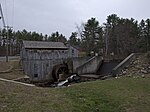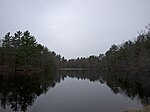Stevens Memorial Hall
1908 establishments in New HampshireBuildings and structures completed in 1910Buildings and structures in Rockingham County, New HampshireChester, New HampshireCity and town halls on the National Register of Historic Places in New Hampshire ... and 3 more
Event venues on the National Register of Historic Places in New HampshireNational Register of Historic Places in Rockingham County, New HampshireQueen Anne architecture in New Hampshire

Stevens Memorial Hall is the historic town hall of Chester, New Hampshire. The building, a large wood-frame structure completed in 1910, is located in the center of Chester at the junction of New Hampshire Routes 121 and 102. The building was listed on the National Register of Historic Places in 2004. It served as the center of the town's civic business until 2000, when town offices were relocated to a former school.
Excerpt from the Wikipedia article Stevens Memorial Hall (License: CC BY-SA 3.0, Authors, Images).Stevens Memorial Hall
Chester Street,
Geographical coordinates (GPS) Address Website Nearby Places Show on map
Geographical coordinates (GPS)
| Latitude | Longitude |
|---|---|
| N 42.956944444444 ° | E -71.258055555556 ° |
Address
Chester Public Library
Chester Street 3
03036
New Hampshire, United States
Open on Google Maps









